Steam and Electric Trams in Malaya
Whilst carrying out my research into the railway systems of Singapore and Malaya I came across references to Steam tramways in Singapore, Johore and Penang. Further research reveals that they did indeed exist in Singapore and Penang, but I have found no evidence of a steam tramway system in Johore, although there was a Johore Wooden Railway and the Muar State Railway, both isolated lines through open country each operated by a single steam locomotive. The confusion probably comes from an old photograph of a tram locomotive with the word “Johore” on the side hauling some double-deck trailers, but this is in fact one of the Penang locomotives, two others being named “Penang” and “Sir Hugh Lowe”.
The Singapore Steam Tramway
Above: Singapore Steam Tram 14 poses on Tanjong Pagar Road by the junction with the old Keppel Road near the tram sheds in 1892. The building behind the DD trailer can also be seen in the third picture on the left and this picture was likely taken from the top of the bank on the right of the third picture.
Below: The Tram sheds off Keppel Road c1892. Note only the shed 3rd from right has smoke guides and chimneys. Most of the vehicles visible appear to be single deck passenger cars as the tram locomotives did not have roof supports at the ends. A double deck tramcar is just visible near the back. Only a few locomotives were fitted with long chimneys.
Above: A long-chimneyed locomotive with a double deck trailer approaches the newly built Bousted Institute in 1992 while a single deck car and loco stand at the entrance to the old Keppel Road.with the police station beyond it.
Below: a Kitson works photograph of Tram number 6, courtesy Stephenson Locomotive Society.
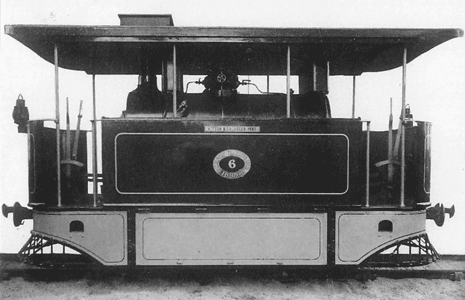
The Tramways Ordinance of 1882 laid down the routes for 5 tram lines to be built as follows:
1. A single line commencing at Crawford Street, Rochor (now Rochore), proceeding along North Bridge Road, South Bridge Road and Tanjong Pagar Road to Tanjong Pagar Docks.
2. A single line commencing near the Pauper Hospital, proceeding along Sirangun (now Serangoon) Road, Selegie Road and Middle Road to a junction with line 1 at North Bridge Road, then turning down High Street to the west end of The Esplanade.
3. A double line commencing on Collyer Quay and proceeding along Robinson Quay, Anson Road and the new road along the line of the Docks to a terminus at the Borneo Company's Wharf.
4. A single line commencing at Boat Quay near Thomson's Bridge, passing along Boat Quay, then by way of Bonham Street through Commercial (now Raffles) Square, to connect with the third line on Robinson's Quay.
5. A single line commencing at Boat Quay and passing along Market Street to connect with the third line on Robinson's Quay.
The High Street section of line 2 and lines 4 and 5 were never built and blanket powers covering future proposals throughout the island were not taken up.
The promoters launched the Prospectus of The Singapore Tramways Company Limited on 8th December 1883 and construction commenced in late 1884, with the laying of the first rails on 7th April 1885. The first 14 Steam Trams had been ordered from Kitson and were completed in 1885 (works numbers 2779 – 2792) but I do not have their shipping details other than the first batch, although at least one was off-loaded in Penang for use on their newly opened Waterfall branch. The first shipment of rolling stock consisting of 4 locomotives, 4 cars and 10 wagons arrived on 10th February and were almost ready for use by the end of March. The traffic Manager, a Mr. Urie, arrived to take up his duties on 13th February and he started by superintending the commissioning of the first batch of rolling stock. The first regular service began over the Tanjong Pagar to Johnston's Pier section of line 3 on 3rd May 1886 and by 1887 lines 1, 2 and 3 were fully open with the exception of the High Street line. These first lines were initially successful and plans were laid for an extension to Geylang whilst two more steam tram locomotives were ordered (Kitson Works numbers 2941 & 2942, built in 1887). A large depot and fully equipped workshops had been built at Tanjong Pagar. The company was not only in the passenger business, for which the standard fare was 10 cents first class and 6 cents second class, but it also published rates for all kinds of goods and parcels, rates generally being 20 cents per ton of foodstuffs or 30 cents per ton of minerals, and 5 cents for a 7 lb parcel rising in stages to 20 cents up to 56 lbs. It was then that an unforeseen problem appeared - the road surfaces were very poor and local carriers soon realised that the tram lines gave a much smoother ride. Bullock carts began to appear constructed to a gauge of one metre so that they could run on the grooved rails and these slowed the trams so much that the passengers preferred to pay the cheaper prices charged by the rickshaws and even the police proved powerless to remove these vehicles from the rails. The Tramway quickly became unprofitable and after 3 years (1889?) the Directors made an unsuccessful attempt to sell the system to the Tanjong Pagar Dock Company as a going concern. They struggled for most of that year year before placing it in the hands of auctioneers who sold it to the Tanjong Pagar Dock Company for a mere S$186,000. The new management made various economies, apparently without much success as lines 1 and 2 were closed at the end of 1892 and line 3 became freight only. In early 1893 the Rochor line was put up for sale along with 12 locomotives and trailers, being advertised for several months by Paterson & Simons but I have no information on their eventual disposal, although some may have gone to Penang. Electrification of the remaining section to the docks was considered but in the end this last section was closed on 1st June 1894. The rails were taken up and many were purchased by the Hong Kong & Shanghai Bank for construction of a new vault but the fate of the rolling stock has not been determined. Perhaps the locomotives and freight wagons found further use in the Tanjong Pagar Docks Company's own railway system which had expanded rapidly by the early part of the twentieth century.
The passenger stock was double-deck trailer cars, similar to those on the Penang Tramway. I have recently found a map showing the precise route including the layout of the depot, reproduced below, but I have not found any details of the running. There is a photograph, taken in Anson Road around 1890, in the book “Singapore then and now” by Ray Tyers and I have a copy of another, apparently taken in the dock area, showing a tram loco and a trailer (see above).
In 1903 the new Singapore Government Railway opened a line from Tank Road to Woodlands, and this was later extended from Tank Road to Pasir Panjang (1907) and taken over by the Federated Malay States Railway in 1913. The northern section from Bukit Panjang is still in use today but the southern section was closed by about 1937 after a new deviation had been built via Bukit Timah and west of the then city to Tanjong Pagar in 1932.
The first Electric experiment
This took place on 16th September 1891 at the New Harbour Dock where a Mr Buckley had use of a 180' temporary track along the dock with an overhead wire for power supply from a generator borrowed from the dock company. He had invited His Highness The Sultan of Johore and several notable Singapore citizens to witness the experiment in the hope that he could win them over to his plan to run an electric tramway from a terminus at Kandang Kerbau on the Serangoon Road, where it would connect with the existing Steam Tramway, alongside the Bukit Timah Road to Kranji. Between 1867 and 1871 plans had been laid for a railway along this route and the Singapore Government had set aside a strip of land 6 miles long towards Bukit Timah Village for this purpose. Mr Buckley intended to use this strip until it was required for the railway and then run alongside the road to Kranji, a further 6 miles. His Highness The Sultan of Johore made several trips up and down the dockside line in the "exceedingly rough and ready tramcar" on "track of the very roughest description" according to the Straits Times of 17th September 1891. He was obviously suitably impressed as witnessed by the next set of experiments the following year on the Kranji Electric Line. Following is the link to this article with more information from this reporter's point of view:
https://eresources.nlb.gov.sg/newspapers/Digitised/Article/straitstimes18910917-1.2.18
The following article adds a lot more technicalities to this experiment and possibly a better explanation also:
https://eresources.nlb.gov.sg/newspapers/Digitised/Article/singfreepressb18910917-1.2.4
The Kranji Electric Line
This is the line on which the September 1892 experiments were carried out. A mile of metre gauge line was laid near the bungalow of His Highness The Sultan of Johore, presumably near Kranji, with overhead line constructed by the Singapore Telephone Company. According to The Straits Times of 12th September 1892 His Highness The Sultan of Johore invited the people of Singapore to visit the line to see it in operation and travel on it if desired when this section opened. The report states that a good many did turn up and partake in the offer but many ladies were reluctant to travel in this manner. The report went on to say that in the event of the experiment being unsuccessful the track and stock would be transferred to the Muar Railway. I have no record of electric traction being tried on the Muar State Railway, but I have now found a copy of the above-mentioned article in the
Straits Times Weekly Issue, 13 September 1892.
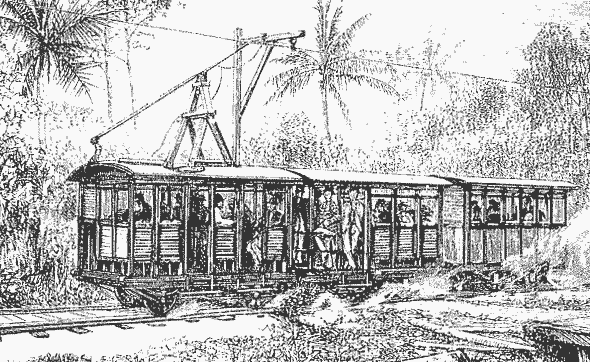
A woodcut depicting The Kranji Electric Line running through the jungle. There appears to be a lot of water being thrown up by the wheels, which might have put prospective travellers off, especially ladies, bearing in mind that the area is subject to frequent heavy showers and associated flooding, especially in late afternoons. (Street Railway Journal, Jan 1893)
Singapore Electric Tramways
An electric Tramway was opened in Singapore in 1905 and gradually expanded with the city. It closed in 1927 when buses took over.
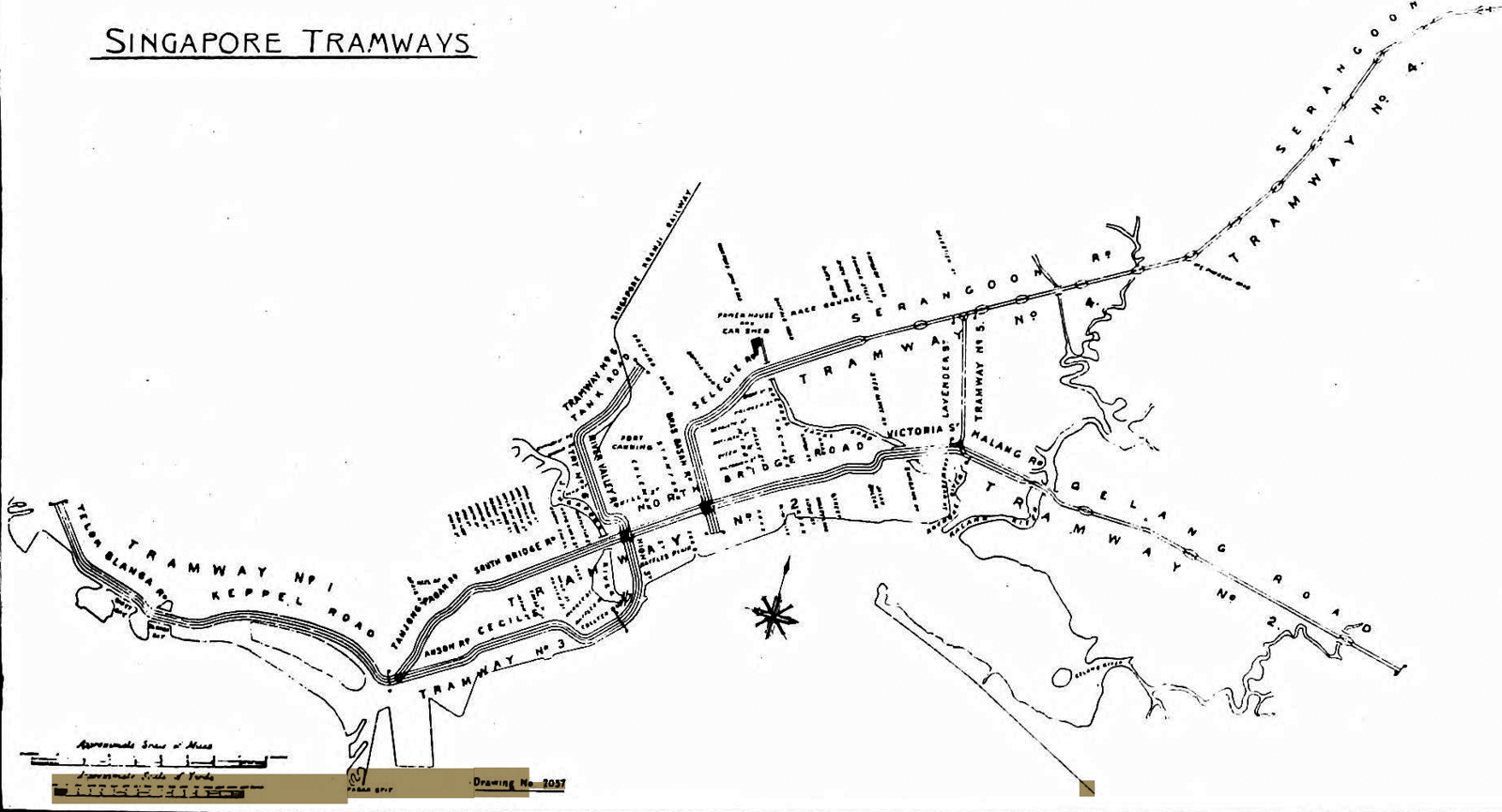
Above: a map showing the planned routes in 1901. In 1904 the Tanjong Pagar Dock Company proposed major changes which would involve a complete realignment of Keppel Road. These works commenced in 1908 and the new road opened in 1910. The smaller map below shows these changes.
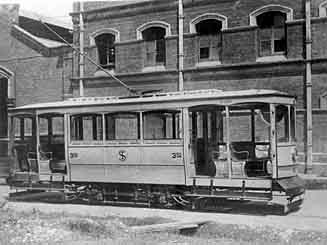
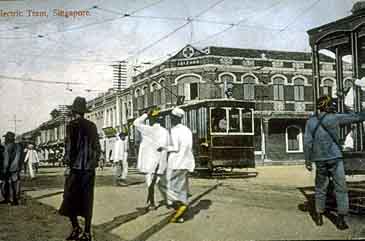
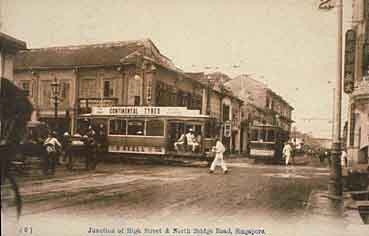
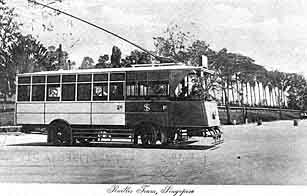
Above and below is a small selection of images of electric trams in operation.
These pictures are taken mostly from old postcards and depict scenes from places such as North Bridge Road, Geylang and Katong.
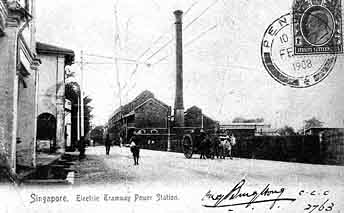
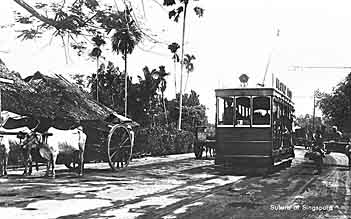
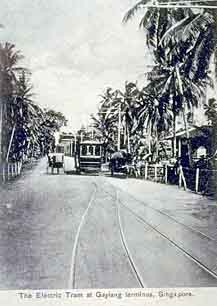
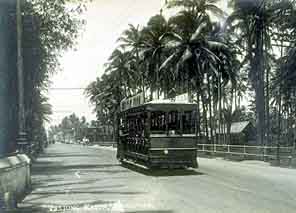
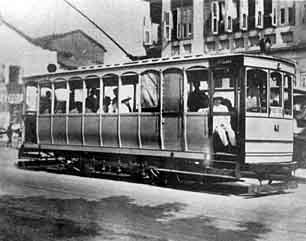
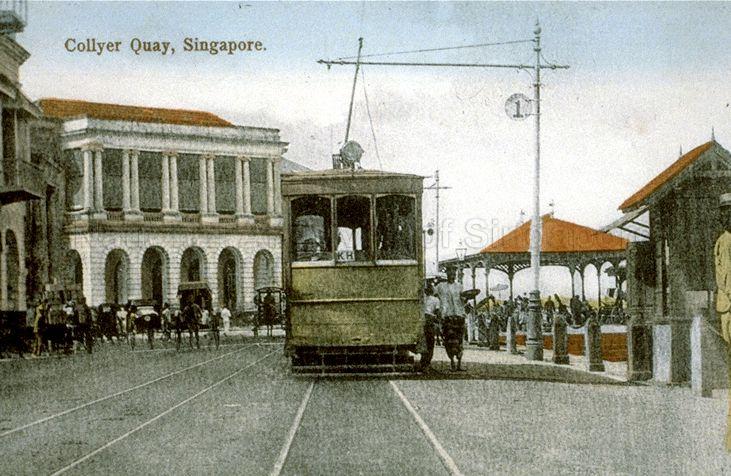
Above: an electric tram stands at Collyer Quay.
Below: History make a single short sentence mention of the acquisition of freight locomotives and wagons and photographs are extremely scarce, the one here being the only one I have come across. The side doors on the locomotive suggests that these were also capable of carrying freight traffic. It could be that they only operated at night to avoid disruption to the passenger services. Here the train is stabled inside the tramcar sheds.
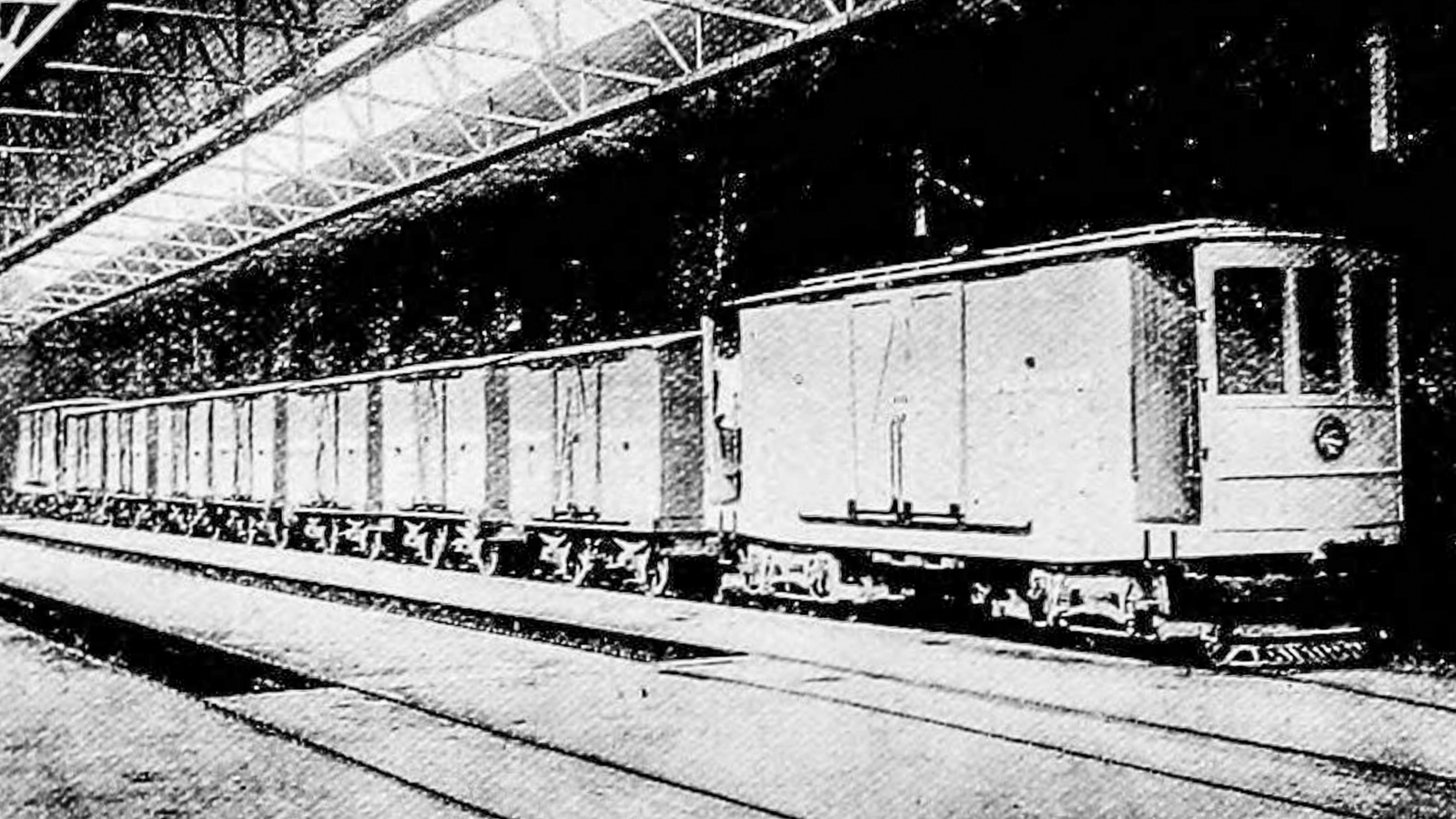
The Penang Steam Tramway
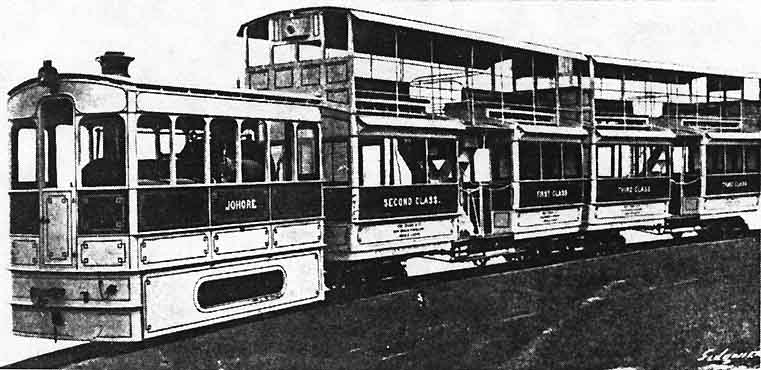
Above: One of the 3 early Steam Tram locomotives, named 'Johore', hauling two double-deck passenger trailers. The other 2 were named 'Penang' and 'Sir Hugh Lowe'.
Below: Abandoned passenger trailers found near the old tram sheds years later.
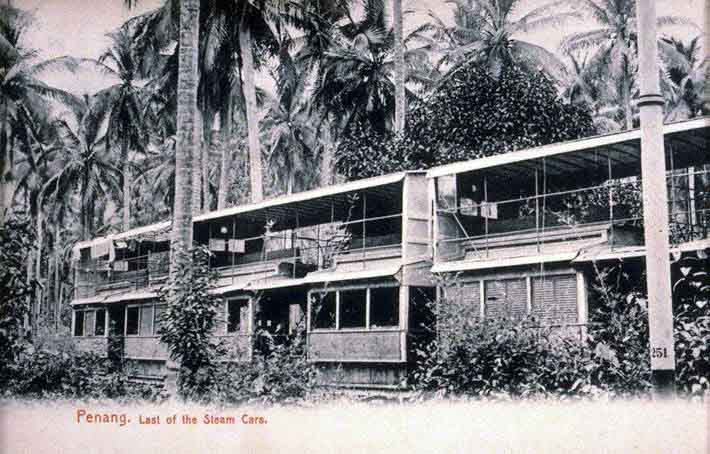
Very little information has come to light regarding this, but most of what there is has been covered in the book “Penang Trams, Trolleybuses and Railways” by Ric Francis and Colin Ganley which also includes the known pictures. I corresponded with Ric during his research for the book but the only information I had was from the Kerr Stuart works list which gives ‘possible’ details for two of the locomotives.
It would appear that the tramway was run by a Mr Gardiner in the 1880s (a Gilbert Gardiner died in Penang in 1889 – was it him or a relation perhaps?). The initial line ran from Weld Quay to Ayer Itam Road, about 7½ miles and in 1885 Mr Gardiner applied to run a new service from Waterfall gardens to the prison, mainly to transport stone from Western Quarries.
Ric says that orders were placed with Kerr Stuart for three steam tram motors which were made by W B Dick at Britannia Engineering Works, Kilmarnock and delivered between 1885 and 1887. Two of these appear in the Kerr Stuart works list which states that they were built by Falcon Engine and Car Works, one possibly being FE 134/87 (KS 532 or 533). What is known is that neither W B Dick nor Kerr Stuart (until 1893) had manufacturing facilities, much of this being sub-contracted elsewhere, including to Barr, Morrison and Co. of Britannia Works, Kilmarnock. In 1883 John Kerr joined W B Dick and they became Dick, Kerr and Co., and in 1884 they took over Barr, Morrison and Co., thus becoming manufacturers.
Ric also says that the Waterfall line was opened using a Kitson Tram locomotive landed in Penang, detoured from an order by Singapore Steam Tramways and that there were eleven steam motors on these routes in 1890. The Kitson trams were also built in 1885 and 1887, according to the Kitson Works list. This begs the questions: “What was being used on the main line to Ayer Itam prior to 1885?” and “Where did the remaining steam trams come from?” Perhaps they acquired some or all of the 12 advertised by Paterson & Simons from Singapore, but I have found nothing to suggest this as yet.
Since the Kerr Bros. London office was shared with W B Dick, who had nothing to do with railways at the time (until Dick invited John Kerr to set up a railway department, which later became Dick, Kerr), it is likely that the original order went to W B Dick, was transferred to John Kerr, who in turn passed it to his brother James Kerr, who worked with Stuart in a Glasgow office where locomotive orders were placed with Falcon Engine and Car Works or Andrew Barclay while rolling stock and track-works were sub-contracted to Hartley and Arnoux Bros. of California Works, Stoke-on-Trent. This gives the Kerr Stuart connection as at one time it was known as “Kerr Stuart’s Penang Steam Tramway Ltd.” Dick, Kerr took control of the Hartley, Arnoux & Fanning (as it was known from 1886) railway and tramway business at Stoke-on-Trent in 1890 (they started to manufacture locomotives around this time) and Hartley went to Kilmarnock to manage the Dick, Kerr works there. The Stoke-on-Trent California Works was acquired by Kerr Stuart on 21st February 1893, as they had previously been sub-contracting most of their work there anyway. The Dick, Kerr Kilmarnock works became part of the English Electric Empire in 1919.
Further details of the above mentioned systems, including electric tramways, trolley buses and motor buses can be obtained from the following books.
Singapore - a History of Trams Trolleybuses and buses by F. W. York and A. R. Phillips , a DTS publication
Penang Trams, Trolleybuses and Railways by Ric Francis and Colin Ganley, published by Areca books, Penang
Page created 30th April 2002.
Updated 11th December 2022

This page has been visited
times.